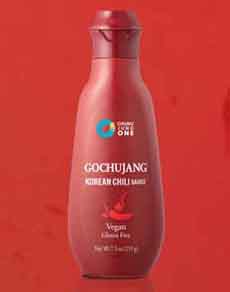TIP OF THE DAY: Gochujang Sauce, The Next Sriracha
|
Over the past five years, sriracha, a Thai hot sauce that most of us had never heard of previously, has emerged as the hot sauce of choice. It’s more flavorful than many of the big-brand American hot pepper sauces that had long been the norm. But climbing up the ladder is a new (to most Americans) hot sauce alternative: gochujang (go-CHOO-jang), sometimes spelled gochuchang). This Korean fermented hot sauce is a mixture of red chili powder, glutinous rice powder, fermented soybeans, salt, other seasonings like garlic and onion, and a bit of sugar syrup or malt. It is then aged. As a result, it is even more complex in flavor than sriracha. Some chefs call it “an umami bomb,” combining spicy, salty, sweet and earthy notes. Gochujang is a staple Korean condiment also known in English as Korean hot pepper paste. Sweet heat with the consistency of hoisin sauce, it’s used in a wide range of Korean dishes, from bibimbap to dukbokki (stir-fried rice cakes) to tteokbokki to something more familiar: fried chicken. And of course, it can be used in American recipes instead of barbecue sauce, ketchup, and other condiments. Some details: Gochujang deepens the flavors (and color!) of everything from broth to noodle dishes and vegetables. Incorporate it into a recipe, or serve it as a table condiment so people can add their own. A group of 18 recipes from Bon Appetit includes recipes for, among others: Add some gochujang to mayonnaise as a spread or a dip for crudités or fries. Serve it plain with eggs. Put it on a burger or hot dog. You can blend in fruit for an even more complex sauce. Add it to dressings, marinades, and sauces to add some spicy flavor. You can make a Korean-style arrabiata sauce for pasta, or pair it with other noodle dishes and rice. Although it contains no tomatoes, some Americans think of gochujang as spicy Korean ketchup. What are you waiting for? Add it to your shopping list! All commercial gochujang is imported, and some labels are only in Korean. “The best gochujang” is a matter of personal taste, like any condiment. You may like more sweetness, or you may like less. If you’re in an Asian market with multiple options, you could ask a clerk to explain the differences. However, as with ketchup, mustard, soy sauce, and other condiments, you won’t find a disappointing one. That said, look for the Chung Jung One brand, which has a squeeze bottle with an American label (photo #1) as plus packaging in a traditional tub for the Korean market (photo #2). If you pursue a close relationship with gochuchang, you may discover different styles, including chalgochujang (sweet rice gochujang) and taeyangcho (sundried, i.e. the paste is actually dried under the sun). |
|
|




